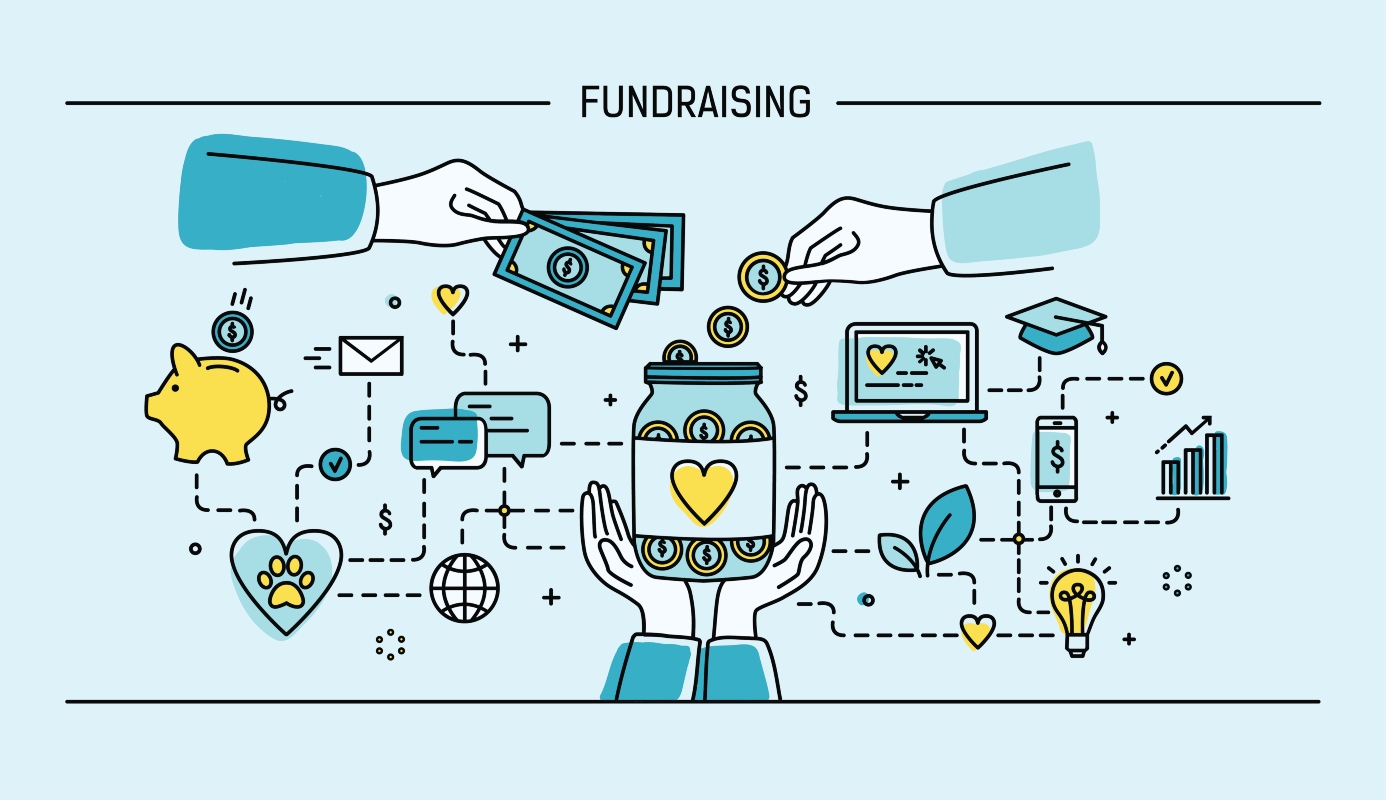Nonprofit fundraising is a common practice among corporate players to show social responsibility. Corporate social responsibility (CSR) is the age-old concept of giving back to the community. It not only allows companies to show they care about society but also creates a positive image for their brands.
Nonprofit fundraising events usually involve hosting an event to raise funds for a specific cause or charitable organization. These programs build goodwill with customers who care about the same issues as your business does.
Now how do you make sure that you’re running a successful nonprofit fundraising event? Here are ten tips:
10 Steps For Running A Successful Nonprofit Fundraising Event

1. Find A Cause And Define Goals
Before reading about Hour-A-Thon football fundraising ideas or similar posts, find a cause to support so that you can then define your event goals and objectives. You will find it so much easier to plan for and execute an event if you select a cause that resonates with your company values.
For example, if you are proactive in educational development, consider raising funds for free educational programs in your chosen locality. You may also consider raising money for a new school building if you found a need to accommodate a rise in the number of students.
Once you decide on that, you can then outline your goals and objectives, which will help you decide the type of fundraiser to choose and tailor the program so that it aligns perfectly with your company’s mission, vision, and values.
2. Find A Beneficiary Organization
Once you set the goals of your fundraising activity, look for a nonprofit organization (NPO) to support and partner with. An NPO can be public schools, public hospitals, churches, labor unions, or volunteer service organizations.
As you look for options in your area, find out about their mission and vision, their history, and how they operate. This gives you an overview of the support they need from corporations like yours.
Before approaching an NPO about your fundraising plans, ensure you have a letter of intent ready. A letter of intent states why you intend to help them and how long you will contribute to their cause. Clarifying your intentions and the details of your plans will let them know how they can help with the organization process.
3. Know How Much You Need To Raise
Determining how much funds you need to raise is necessary. Having a concrete idea of your fundraising target will let you properly gauge how many corporate donors you need and how much money to request from each of them.
To come up with this figure, you can discuss the financial details with the beneficiary NPO and then research the expected costs of these projects.
4. Involve Your Employees
Nonprofit fundraising events will produce the desired long-term results when you involve your employees in the brainstorming, organization, and execution stages. Designating roles inspires collaboration and engagement and may even boost employee retention.
Here’s a list of tasks that your employees can take part on:
- Advertising the fundraiser
- Organizing the event
- Training volunteers
- Coordinating with vendors
- Selling tickets for the event
- Managing received funds
- Tracking the performance of the fundraiser
By trusting your workforce with the fundraising campaign’s success, you create a win-win situation for everyone involved. Your employees will be inspired to work harder knowing they are helping create a better society.
Aside from that, a good brand image will entice prospective employees to be part of your company since you’re showing that you care about more than just making money—you also care about making a difference.
5. Identify A Timeline
If the project is long-running, you must set up a timeline of how long the entire campaign will take. A timeline helps you identify when the different phases of the campaign will start and end.
Since you will be able to pin down every activity necessary, a timeline can also serve as a reference for your budget. It will also create a sense of urgency for your supporters, encouraging them to act promptly and accordingly.
For example, if your goal is to raise US$10,000 in six months, you can break down your efforts into these four smaller steps:
- Determining the type of events to hold
- Identifying a venue
- Promoting the event
- Managing the process of collecting donations
With a specific timeline, increasing donor conversion rates is possible.
6. Create A Budget
To prevent overspending and incurring a deficit, create a budget. In a typical setup, the crucial areas to allocate a budget for include travel, printing costs, staff compensation, and meals.
Once you’re done making financial assessments, use your timeline to determine how much you can spend each day. This is especially crucial for a long-running campaign. To arrive at a good conservative estimate, you’ll have to consider the day’s activities. Since there might be different phases during the entire campaign, the daily activities may vary and, therefore, have different budgets.
If you’re not planning an in-person event, consider setting up a virtual one instead. However, there are still costs associated with it if you want to ensure its success. It includes marketing, web development, and technologies that support ticketing, registration, and hosting files. So make sure to factor these into your budget plan as well.
7. Research About Fundraising Types
After calculating the budget, it’s time to look for fundraising types. This is crucial as you must determine which activity is ideal for your business. Find out about the different types of fundraising events:
- Event Fundraising is a traditional approach to raising funds by gathering people together in one place where they can participate in the event activities. These events raise funds through registration fees and sponsorships. Concerts, marathons, galas, and fashion shows are some of the most notable fundraising events.
- Fundraising Platforms are websites where organizations can post their project idea and receive donations from people with similar interests. They provide a platform for both parties to connect, where the nonprofit organization can get assistance from the business owners in exchange for a donation.
- Social Media Campaigns are an excellent way to reach out to potential donors and offer them an opportunity to donate to your cause. You can create ads on Facebook, Twitter, or Instagram, asking online users to donate money toward the cause.
- Merchandise Fundraising is another great way to raise funds for the nonprofit organization you’re supporting. It involves selling products in exchange for donations, such as t-shirts, mugs, bracelets, and wristbands that carry a statement that support the cause.
- Auction Fundraising includes auctioning off valuable items, like custom artwork or signed memorabilia. This allows people to bid on items they desire while supporting something they care about. Moreover, the price rising every time a bidder is a great way to attract money for your fundraising campaign.
If you can determine which fundraising types work for your company, selecting the most appropriate one is more accessible.
8. Establish A Prospect List
Before you start organizing your fundraising campaign, you’ll need to have a prospect list. You can approach high-class personalities in your community, such as politicians, other business owners, and celebrities with a vast influence. These individuals can also raise awareness for the cause.
You can establish a prospect list by building a donor database, a hub where you can store and monitor donor information. It includes their names, email addresses, donation amount, and past involvement with your organization. However, you must know where to look for potential donors. You can start with social media profiles of local businesses and celebrities. This helps you understand who may be willing to support your cause.
9. Make It Easy For People To Donate
There are instances when donors want to make their donations more conveniently. Some may be uncomfortable donating in cash due to security reasons.
If you give them multiple payment options—such as wire transfers, cheques, online donations, and credit card payments—you know they are choosing a method they are most comfortable with. Stretching their options increases your chances of receiving more donations.
10. Follow Up With The Donors
Once the fundraising event is over, sending gratitude messages is a must. It shows that your company values the cause and lets donors know you appreciate their contributions. Doing so may encourage them to support your future campaigns.
Besides a ‘thank you’ message, consider using this opportunity to collect participant feedback. Ask them about their experience and whether they’d recommend it to their peers. If you ever support another fundraising campaign, use these insights to improve your next event to make it even better.
Additionally, don’t forget to update the donors on the campaign’s progress. For instance, if you’ve reached your target fund amount of US$10,000, be transparent to the contributors about this milestone and reiterate how you will be using the money.
It will also be in every party’s best interest if you let them know the impact or results of the campaign—whether you’ve hit all your goals. This shows that you value them as your stakeholders, and that will make it easier for them to establish trust with your company.
Conclusion
Like any CSR initiative, nonprofit fundraising can have long-term positive effects on brand image, especially when planned and executed properly.
A company’s philanthropic efforts aren’t only beneficial for its bottom line; they help create a positive difference in a community. In addition, it helps build trust with contributors, consumers, and potential investors, which can help your business grow.
Read Also:
- 6 Ways Attending a Crowdfunding Event Can Boost Your Business
- How to Run a Successful Crowdfunding Campaign
- 5 Ways of How Having Business Events Will Benefit One’s Marketing Campaign















